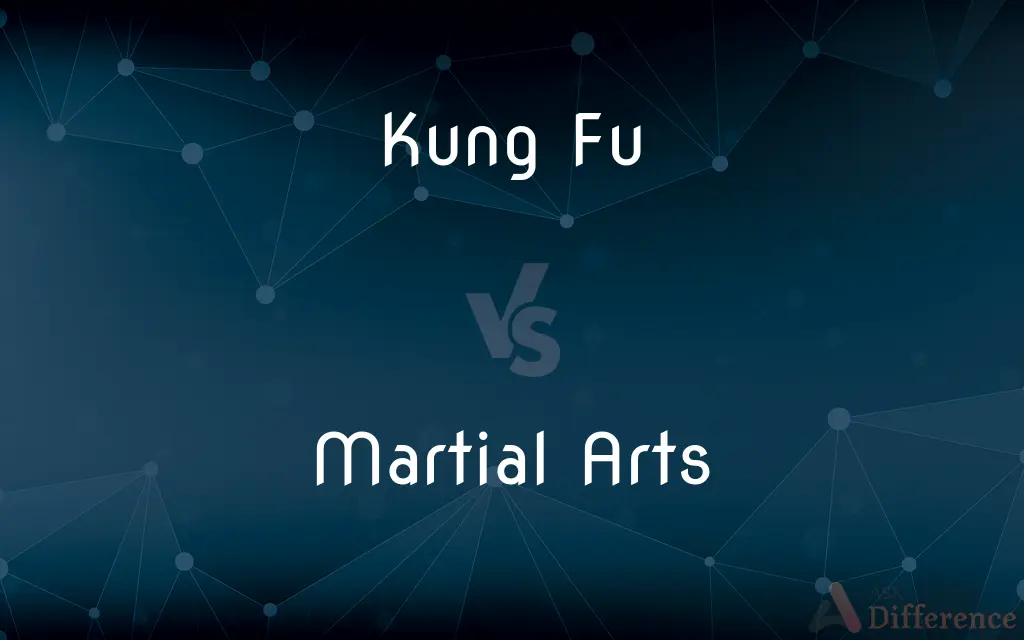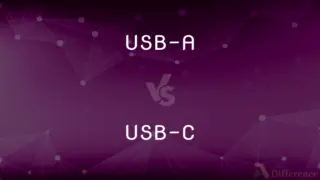Kung Fu vs. Martial Arts — What's the Difference?
By Tayyaba Rehman & Fiza Rafique — Published on February 10, 2024
Kung Fu refers to the Chinese martial arts, focusing on hand-to-hand combat and self-discipline, while Martial Arts is a broad term for various fighting systems worldwide, including Kung Fu.

Difference Between Kung Fu and Martial Arts
Table of Contents
ADVERTISEMENT
Key Differences
Kung Fu and Martial Arts are terms often used interchangeably but represent different concepts in the world of combat and self-defense. Kung Fu, originating from China, is not just a fighting style but a complex discipline involving physical exercise, fighting techniques, mental discipline, and a deep philosophical basis. Martial Arts, on the other hand, is an umbrella term that includes all forms of combat and self-defense practices, including Kung Fu, from various parts of the world, each with its unique philosophy and technique.
While Kung Fu emphasizes fluidity of movement, internal strength, and the philosophical aspects of combat, viewing it as a way to achieve greater self-understanding and spiritual growth, Martial Arts as a whole can vary greatly in their approach. Some martial arts, like Karate or Taekwondo, focus more on strikes and kicks, and may or may not incorporate the philosophical depth found in Kung Fu.
The training methods in Kung Fu often include traditional weaponry, animal mimicry, and Qi Gong, aiming to develop the practitioner's physical, mental, and spiritual harmony. In contrast, Martial Arts, depending on the specific style, may have a more straightforward approach to combat, focusing on physical prowess and technique, with varying emphasis on spiritual development.
In terms of global influence, Kung Fu is known worldwide largely due to cultural exports like movies and literature, portraying it as a highly stylized and philosophical martial art. Martial Arts, however, encompasses a wide range of practices from different cultures, each with its representation in media and global presence, be it through sports like Judo in the Olympics or through local self-defense classes teaching Krav Maga.
Lastly, the perception of Kung Fu and Martial Arts can also vary culturally. In the West, Kung Fu is often seen as a monolithic representation of Chinese martial arts, while in its country of origin, it's known as Wushu and is seen as one of the many components of traditional Chinese culture. Martial Arts, globally, is recognized as a category that includes various forms, each with its own cultural and historical background, such as Brazilian Jiu-Jitsu, Japanese Karate, or Korean Taekwondo.
ADVERTISEMENT
Comparison Chart
Origin
Specifically from China.
Various global origins.
Focus
Combines physical exercise, self-defense, and philosophy.
Varies, can be self-defense, sport, or spiritual growth.
Techniques
Involves fluid movements, animal mimicry, and Qi Gong.
Includes strikes, grappling, throws, and weaponry.
Cultural Representation
Often portrayed in media as a highly stylized art form.
Represented widely in sports, films, and literature.
Philosophical Depth
Deeply intertwined with Chinese philosophy and spirituality.
Varies greatly among different styles.
Compare with Definitions
Kung Fu
Kung Fu emphasizes internal strength and the flow of Qi energy.
Through Kung Fu, she learned to channel her Qi for both healing and defense.
Martial Arts
Martial Arts training focuses on physical fitness, technique, and mental fortitude.
His Martial Arts training has improved his endurance and focus.
Kung Fu
Kung Fu is a Chinese martial art known for its fluid movements and deep philosophy.
He practices Kung Fu not just for self-defense but also for mental and spiritual growth.
Martial Arts
Martial Arts can be categorized into striking, grappling, and weapon-based styles.
Karate and Taekwondo are popular striking styles in Martial Arts.
Kung Fu
Kung Fu is not just a fighting technique; it's a way of life that promotes discipline and moral development.
His dedication to Kung Fu has made him a disciplined and respectful individual.
Martial Arts
Martial Arts are practiced for various reasons, including self-defense, competition, and spiritual development.
She practices Martial Arts to stay fit and learn self-defense.
Kung Fu
Kung Fu involves mastering forms that mimic animal actions and natural elements.
The crane style in Kung Fu is admired for its balance and grace.
Martial Arts
Martial Arts encompasses various fighting systems and techniques for self-defense.
Martial Arts classes teach not only combat skills but also respect and discipline.
Kung Fu
Kung Fu training often includes traditional weapons and acrobatics.
He excels in Kung Fu, particularly in the art of the staff and the sword.
Martial Arts
Martial Arts often reflect the cultural and philosophical traditions of their country of origin.
The principles of Bushido are deeply ingrained in Japanese Martial Arts.
Kung Fu
Alternative spelling of kung fu
Common Curiosities
What is the primary goal of Kung Fu?
To achieve harmony between mind, body, and spirit through discipline, practice, and understanding of philosophy.
Is Kung Fu practical for self-defense?
Yes, Kung Fu teaches effective self-defense techniques along with situational awareness.
Can Kung Fu be used in competitive sports?
Yes, there are competitive events like Wushu tournaments that showcase Kung Fu skills.
Are all Martial Arts focused on combat?
While self-defense is a common element, many Martial Arts also emphasize spiritual growth, discipline, and physical fitness.
Do all Martial Arts include weapon training?
Not all, but many Martial Arts have traditional weapons as part of their curriculum.
How does the philosophy of Kung Fu influence its practice?
The philosophy encourages mindfulness, respect, and an understanding of the interconnection between mind, body, and nature.
Is it necessary to be physically fit to start learning Kung Fu or Martial Arts?
No, one can begin at any fitness level, and the practice itself improves physical fitness over time.
Is Kung Fu suitable for all ages?
Yes, Kung Fu can be adapted for different age groups, focusing on age-appropriate techniques and philosophies.
How do Kung Fu and Martial Arts handle conflict resolution?
Both often emphasize avoiding conflict and using combat skills only when necessary, promoting peace and self-control.
Are Kung Fu and Martial Arts effective in real-life self-defense situations?
Yes, both teach practical self-defense techniques and situational awareness, though the effectiveness also depends on the practitioner's skill and experience.
Can Kung Fu and Martial Arts be a form of meditation?
Yes, many practitioners find the focused and deliberate movements to be a form of moving meditation, promoting mindfulness and relaxation.
How does one choose the right Martial Art or Kung Fu style?
It depends on personal goals, interests, fitness level, and the desire to explore a particular culture or philosophy. It's best to try a few classes and speak with instructors before deciding.
What distinguishes Martial Arts from other forms of physical activity?
Martial Arts not only focuses on physical fitness but also on mental discipline, self-defense skills, and often a philosophical or spiritual component.
How important is discipline in Kung Fu and Martial Arts?
Discipline is fundamental, as it fosters consistency in practice, respect for the art, and personal growth.
Do Kung Fu and Martial Arts require a spiritual or cultural belief system?
No, while they are influenced by their cultural origins, individuals can practice and benefit from them regardless of their personal beliefs.
Share Your Discovery

Previous Comparison
USB-A vs. USB-C
Next Comparison
Apple iPad vs. Apple LaptopAuthor Spotlight
Written by
Tayyaba RehmanTayyaba Rehman is a distinguished writer, currently serving as a primary contributor to askdifference.com. As a researcher in semantics and etymology, Tayyaba's passion for the complexity of languages and their distinctions has found a perfect home on the platform. Tayyaba delves into the intricacies of language, distinguishing between commonly confused words and phrases, thereby providing clarity for readers worldwide.
Co-written by
Fiza RafiqueFiza Rafique is a skilled content writer at AskDifference.com, where she meticulously refines and enhances written pieces. Drawing from her vast editorial expertise, Fiza ensures clarity, accuracy, and precision in every article. Passionate about language, she continually seeks to elevate the quality of content for readers worldwide.













































